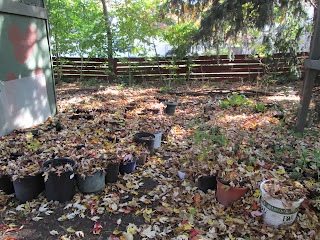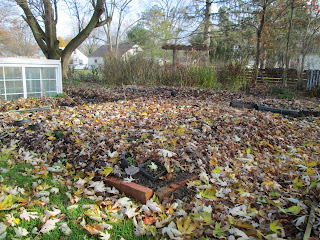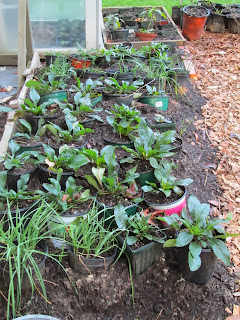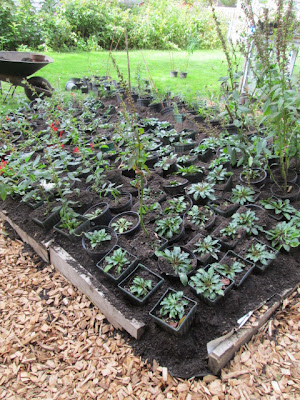 |
| NOG - September 2013 |
No Hoop-house? No Problem
Wintering over native perennial plants without a hoop-house or greenhouse is not as difficult as you might think. As a matter of fact experimenting with different techniques that help ensure their survival is fun and rewarding.
Native plants typically flower their second or in the case of some stubborn ones like Jack-in-the Pulpit their third season. Introducing market customers to the benefits of gardening with native plants is self-explanatory, if I allow flowering species like: Cardinal Flower, Prairie Phlox and Butterfly Weed to do the "talking".
I use three different methods to help our native plants ride safely through Cleveland Ohio's unpredictable winters: recycled windows, double-layered nursery pots and a compost/soil mixture.
Recycled Windows
 |
| Our fanciest cold-frame |
I suppose, I could set up a series of "window islands" to protect all the plants, but this really would be over kill. One of the great things about native plants is their hardiness. They solved the puzzle long ago of how to best adapt to shortened day light hours and colder temperatures. How they have learned to deal with our fluctuating temperatures and ever changing conditions is truly remarkable.
Double Pots & Neighborhood Leaves
 |
| Woodland plants waiting out winter |
Thanks to the generosity of my market customers I have an abundance of recycled nursery pots. These gifts, which come in all shapes and sizes, are certainly appreciated! The majority of them are used to re-pot future plants, some however are a bit to large for lugging to the market. It didn't seem right to throw them out, so a plan was devised which put them to good use. Our solution... winter storage containers.
We are Thankful for the Generous Donations
 |
| Nursery pot within a pot |
Once extra containers are filled with leaves they make a nice cozy nest for Solomon's Seal, Bellwort, Poke Milkweed and others. Tipping the perennial slightly allows for easy water run off. The first year I tried this I waited too long in the spring before straightening the dormant stock. Boy did they grow lopsided! Of course everything eventually realigned itself, but it took a while.
Finally, I use the leaves collected by my neighbors to fill in nooks and crannies.
Marathon Method - Soil & Leaves
The last method a friend of mine calls the "marathon method", in her opinion the reason it works for me is that I put on my "marathon mentality". Agreeably, this technique is highly labor intense, however combining: soil, compost and leaves is an extremely effective insulator.
Each fall I order two yards of good soil and one of compost. The plant storage areas that we have created are then filled with 4 to 5 inches of the compost/soil mixture. Once again we tip the plants just a bit and fill in extra spaces with leaves. If you live in an area where there aren't leaves for your neighbors to collect then perhaps straw or newspaper would work.
This is traditionally a fall project for three reasons. The first is the fact that once the growing season is over I have more free time. Second cleaning compost from potted plants before each farmer's market would take hours. Lastly, is the fact that decomposing leaves add valuable nutrients to what will become part of next springs potting soil.
Nature's Insulator Free & Effective!
Protective Blanket
 |
| First layer of leaves |
This is the part that is the most difficult, waiting patiently before covering the perennials with a nice blanket of leaves. Once the temperatures remain relatively cold then we put on the final winter covering.
Snow is the best protection, there have been times when I shoved piles extra snow on plants to protect them from a potential thaw.
Snow is the best protection, there have been times when I shoved piles extra snow on plants to protect them from a potential thaw.
Lessons Learned
 | |
| As you can see I haven' t finished pruning |
Start Early - Mid September is a good starting point. I wouldn't suggest making this a weekend project.
Create a Map - It is very easy to lose plants, believe me I have done it. A good old fashion hand-made map indicating north and south is tremendously helpful in the spring.
Forget Core Workouts - I am always looking for excuses not to do sit-ups, weights, stretching etc. This isn't hard work but it does take, time energy and lots of bending.
Do you have any creative ways of wintering over your native plants? If so I would love to hear about them.
Do you have any creative ways of wintering over your native plants? If so I would love to hear about them.
.



thank you so much for sharing!
ReplyDeleteYou are welcome.I always feel better when my plants are covered with snow like they are right now.
ReplyDelete